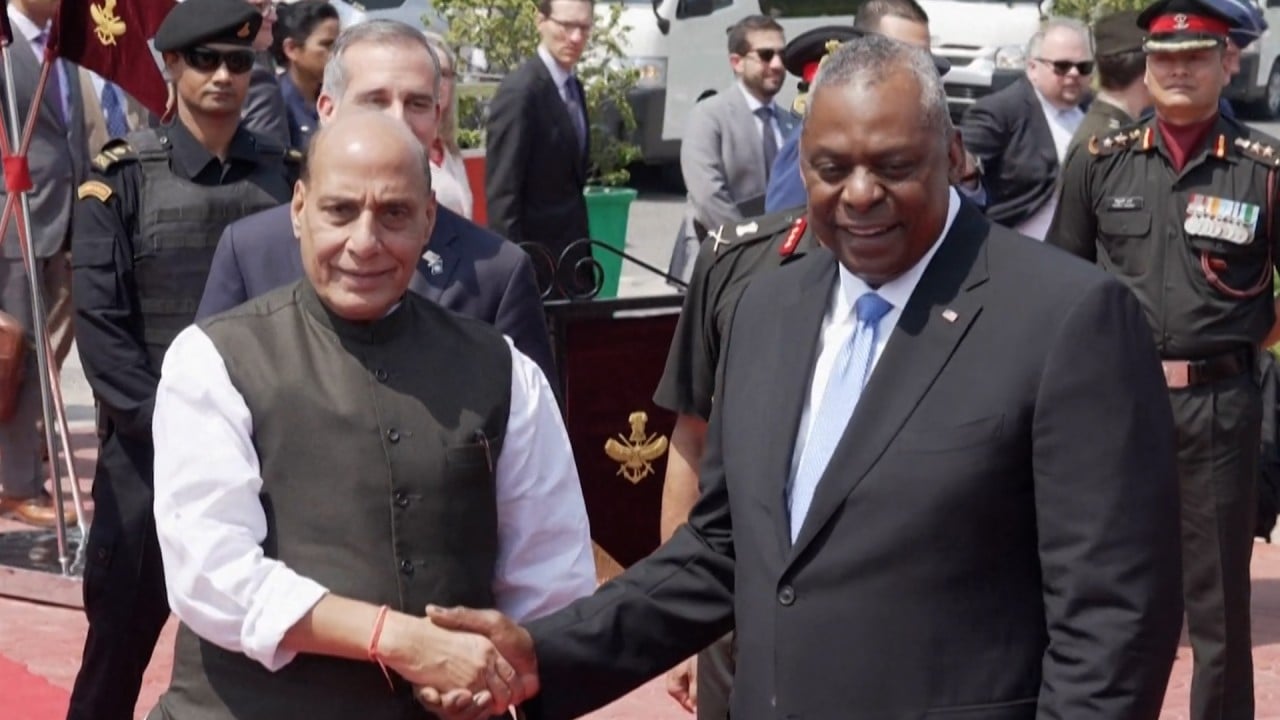
India, US boost defence ties with Russia, China in mind: ‘things are changing’
- A slew of deals may be Washington’s way to wean India off its reliance on Russia, analysts say, part of a larger Western push to sell New Delhi arms
- They say the West believes India may alter its foreign policy priorities if it’s less dependent on Russia, as it eyes deepening Moscow-Beijing ties
The two have even finalised a new initiative, INDUS X, that Austin said “aims to jump-start” innovation between private defence firms in both countries.
The US promising to step in could be a win-win defence partnership for both Washington and Delhi, analysts said.
For the US, uncomfortable with Delhi’s refusal to criticise Moscow, the moment might be ripe, said Rajan Kumar, an associate professor at Delhi’s Centre for Russian and Central Asian Studies at Jawaharlal Nehru University, who specialises in India-Russia ties.
“The West believes that if India becomes less dependent on Russia, it will also change its priorities in terms of its foreign policy,” said Kumar, referring to Delhi’s refusal to openly criticise Moscow for its invasion of Ukraine.
Other analysts argue that reducing Indian dependence on Moscow is possible only if the US and other Western military powers shed their traditional reluctance to share defence equipment and technology with Delhi.

“For a long time, strategic thinkers have been arguing that for India to change its foreign policy choices, the West would have to make a conscious decision to share defence technologies with India so it doesn’t rely on Russia,” said Rajeswari Pillai Rajagopalan, director of the Centre for Security, Strategy and Technology at the Delhi-based think tank Observer Research Foundation.
“It feels like the US is also coming to the same realisation,” she added.
Delays, disruptions
According to Washington think tank The Stimson Centre, which focuses on global peace and security, 85 per cent of major Indian weapons systems come from Russia.
Data from the Stockholm International Peace Research Institute shows that of all the arms India imported between 2018 and 2022, 45 per cent originate in Russia, followed by 29 per cent from France. The US was a distant third, making up 11 per cent of Delhi’s weapons imports.
Since the Russian invasion of Ukraine, however, this dependence has been fraying.

Moscow’s invasion has ended up causing delays as well disruptions in defence deals it has signed with Delhi, with two warships manufactured by Russia likely to be delayed by at least six months.
Two remaining air defence missile systems will also be delayed, according to news reports.
A key part of these sanctions involves obstructing Moscow’s access to dollars. This has led Russia and India to discuss trading in roubles or rupees, but no agreement has yet been reached.
According to Kumar – speaking from Moscow where he is attending a conference – many in Russia were “anxious” about the payments crisis as India’s import bill was burgeoning with no real fix in sight.

The China factor
“Russia has grown very, very close to China and there are material consequences to that relationship growing stronger,” said Rajagoplan. “Moscow is now providing more advanced weapons and military platforms to China today than ever before and this will have a direct consequence on India’s ability [to respond to China],” she added.
Delhi realised that Beijing was now a more consequential partner to Moscow, she said. “There’s a creeping acknowledgement [in Delhi] that things are changing, that it’s a very different Russia today.”

It is in this context that stronger defence ties with Washington become a lucrative option for Delhi, and “managing China” is now central to the India-US relationship, Rajagopalan said.
Austin, during his India visit, called the Delhi-Washington partnership the “cornerstone of [a] free and open Indo-Pacific”.
Yet others believe that the road to pushing Russia away will not be smooth for India and think balancing Washington’s priorities in South Asia may be a hindrance for Delhi.
“With the US, there is a different kind of dilemma on their side: they want an India that is militarily strong enough to be part of a strategy to balance and deter China, but not an India that is militarily strong enough to cause concern in Rawalpindi [where the Pakistan Army’s headquarters is located],” said Prabhat Shukla, former Indian ambassador to Russia.
India’s attempts to walk away from Russian arms will be a slow process, added Kumar, as “once you have so many [Russian-made] Sukhoi jets with you, you cannot suddenly switch to [American] F-16s. It takes time. While India will diversify its imports, for the next five to 10 years its reliance on Russia will remain”.


